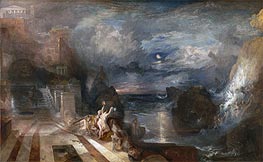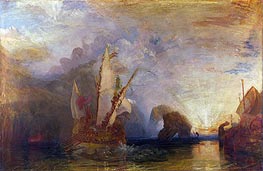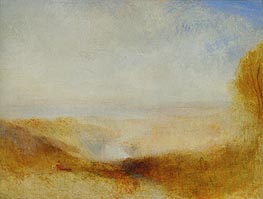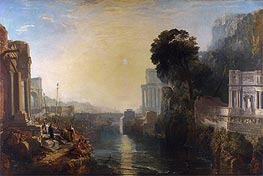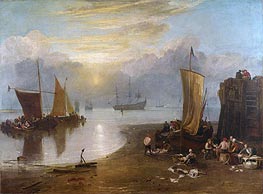Calais Pier with French Poissards Preparing for Sea: an English Packet Arriving, 1803 by Joseph Mallord William Turner
Canvas Print - 14405-TJW
Location: National Gallery, London, UKOriginal Size: 172 x 240 cm
Giclée Canvas Print | $58.56 USD
Your Selection
Customize Your Print
By using the red up or down arrows, you have the option to proportionally increase or decrease the printed area in inches as per your preference.
*Max printing size: 29.7 x 41.3 in
*Max framing size: Long side up to 28"
"Calais Pier with French Poissards Preparing for Sea: an English Packet Arriving" will be custom-printed for your order using the latest giclée printing technology. This technique ensures that the Canvas Print captures an exceptional level of detail, showcasing vibrant and vivid colors with remarkable clarity.
Our use of the finest quality, fine-textured canvas lends art reproductions a painting-like appearance. Combined with a satin-gloss coating, it delivers exceptional print outcomes, showcasing vivid colors, intricate details, deep blacks, and impeccable contrasts. The canvas structure is also highly compatible with canvas stretching frames, further enhancing its versatility.
To ensure proper stretching of the artwork on the stretcher-bar, we add additional blank borders around the printed area on all sides.
Our printing process utilizes cutting-edge technology and employs the Giclée printmaking method, ensuring exceptional quality. The colors undergo independent verification, guaranteeing a lifespan of over 100 years.
Please note that there are postal restrictions limiting the size of framed prints to a maximum of 28 inches along the longest side of the painting. If you desire a larger art print, we recommend utilizing the services of your local framing studio.
*It is important to mention that the framing option is unavailable for certain paintings, such as those with oval or round shapes.
If you select a frameless art print of "Calais Pier with French Poissards Preparing for Sea: an English Packet Arriving" by J. M. W. Turner, it will be prepared for shipment within 48 hours. However, if you prefer a framed artwork, the printing and framing process will typically require approximately 7-8 days before it is ready to be shipped.
We provide complimentary delivery for up to two unframed (rolled-up) art prints in a single order. Our standard delivery is free and typically takes 10-14 working days to arrive.
For faster shipping, we also offer express DHL shipping, which usually takes 2-4 working days. The cost of express shipping is determined by the weight and volume of the shipment, as well as the delivery destination.
Once you have added the paintings to your shopping cart, you can use the "Shipping estimates" tool to obtain information about available transport services and their respective prices.
All unframed art prints are delivered rolled up in secure postal tubes, ensuring their protection during transportation. Framed art prints, on the other hand, are shipped in cardboard packaging with additional corner protectors for added safety.
Painting Information
Composition is the first thing that grabs the attention here, with the ferry at center stage just moments from a potential clash along the Calais pier. The wind-whipped figures, both on the boat and the shore, appear hectic yet purposeful, echoing the tension of Turner’s own stormy crossing in 1802. One can practically hear the shriek of gulls and feel the slap of sea spray. The wooden pier juts sharply into the turbulent water, directing the eye toward the loaded packet boat and then pushing it outward to the gathering clouds overhead. Everything swirls around that luminous sail, a slice of brightness in a brooding scene.
Next, the color scheme delivers a remarkable interplay between grim weather and fleeting light. The mass of clouds is an assembly of charcoals and inky blues, but there’s a moment of radiance that hits the white sail and lifts the composition from total gloom. Layered greens of the channel surge beneath it all, as though they’re carrying the weight of the painting’s drama. This palette constantly reminds us we’re on the cusp of disaster, yet also teases that there’s a hint of reprieve—if only the storm should pass.
On to the technique: thickly applied paint, especially in the roiling foam of the waves, was highly unusual for the time and met with predictable confusion. Critics accustomed to transparent glazes balked at these blotches of heavy impasto. Yet, it’s precisely that freedom of application that captures the unbridled force of nature. No refined brushwork here in the sea’s churning; it’s all palette knives and gutsy strokes, giving the waves a tactile ferocity that pulls the viewer right into the heart of the channel.
Historically, Dutch maritime painting influences can be felt throughout, especially in the arrangement of ships and Turner's preoccupation with dramatic weather. But there’s also an ebullience in the figure group along the pier, suggesting a nod to British genre painting and even a dash of humor reminiscent of Hogarth’s bustling scenes. Exhibited in 1803, it drew both fascination and scorn, signaling the start of ongoing debates over the artist’s unconventional approach. Traditionalists found the surface jarring, likening the paint to everything from soup to soap. Nonetheless, the painting persisted in Turner’s own collection, standing as a defiant statement of a bold new direction in maritime art.

















